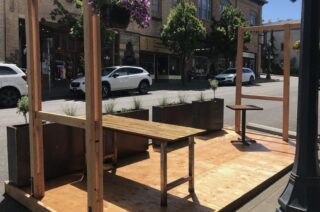
(Image: City of Hood River)
The Oregon Department of Transportation is trying.
The agency that’s pushing to expand freeways throughout the Portland region and has become Oregon’s de facto advocacy organization for car users, wants to be seen as innovative and nimble; but a situation in the city of Hood River shows the lengths businesses had to go just to use a few curbside parking spaces on one of the agency’s state highways.
Earlier this month businesses along Hood River’s main drag of Oak Street started building “street seat” installations to give customers more space to eat and drink. The efforts were part of a parklet permit program launched by the City of Hood River at the end of June.
“[The parklets] are not acceptable in terms of where they are and how they’re constructed.”
— Rian Windsheimer, ODOT Region 1 Director
But according to ODOT’s Region 1 Manager Rian Windsheimer, Hood River never received final approval to permit businesses on Oak Street — which happens to be State Route 30, an ODOT-owned highway. “Unfortunately, Hood River proceeded with allowing businesses to go and put those in place on the Historic Highway and the State Highway without working with ODOT to approve the parklet plans,” Windsheimer told members of the Historic Columbia River Highway Advisory Committee at their meeting on July 13th.
Windsheimer went on to say that he supports the parklet idea, but the wooden benches, tables and other features built in the parking lane, “Are not acceptable in terms of where they are and how they’re constructed.”
ODOT claims their hands are tied due to federal Highway Trust Fund policy that allows only “transportation related activity” on state right-of-way.
One of ODOT’s suggestions was to relocate the parklets onto sidestreets; but the City of Hood River didn’t like that idea. “It’s a very fluid situation, we’re trying to figure out what to do,” Windsheimer said at the meeting.
Advertisement
Two days later local media reported that ODOT crews planned to remove the parklets. Fortunately Windsheimer intervened and continued to negotiate with business owners. Those discussions helped inform official ODOT design guidance and a permit process for businesses along state highways.
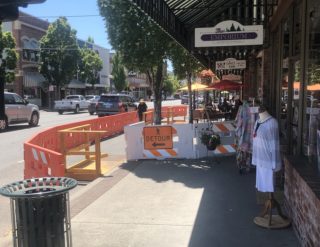
On July 20th, ODOT released a statement about their new Reopening Communities, Re-envisioning Spaces Program, an effort to, “Re-envision how to safely adapt public spaces within the state highway system.” ODOT offered an example of a business in Grants Pass that received a permit to place two tables on a sidewalk.
The big catch with ODOT’s permit program is that the agency will only allow “transportation” uses on state highways. This means no parklets or seating in the roadway. As you can see in the image ODOT shared from Grants Pass, the only new use they permit in the highway is people walking. “ODOT urges cities to re-envision additional [parking] spaces with ideas like detouring local traffic onto state highways, using alleys or empty lots, or transferring ownership of state sidewalks or streets to the city,” their statement said.
In order to maintain their outdoor dining tables and seating on the street, the City of Hood River had to request a jurisdictional transfer from ODOT to the city. ODOT has obliged and is working out the details. According to a story in Hood River News published Wednesday (7/22), one of the businesses will be allowed to keep their parklet on Highway 30, while another will have to move it to a private parking lot behind their business.
The businesses claim they built these parklets because ODOT signaled support, then they were threatened with having to remove them, now ODOT says some of them can stay. What a mess.
One interesting takeaway from this is how ODOT interprets the “transportation related activity” definition from the Highway Trust Fund. Under their interpretation, an empty parked private vehicle is transportation related, but an empty dining table is not. If ODOT is truly committed to, “re-envisioning how to safely adapt public spaces within the state highway system,” perhaps they should be more flexible. What if they allowed parklets as long as they’re equipped with wheels?
In related news, Washington’s DOT released a program earlier this month that gives local jurisdictions permission to re-allocate space on state highway lanes for the exclusive use of walkers and rollers.
— Jonathan Maus: (503) 706-8804, @jonathan_maus on Twitter and jonathan@bikeportland.org
— Get our headlines delivered to your inbox.
— Support this independent community media outlet with a one-time contribution or monthly subscription.

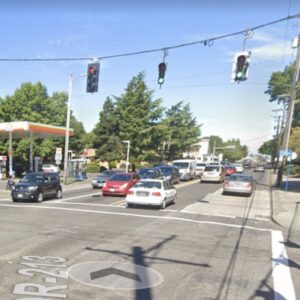
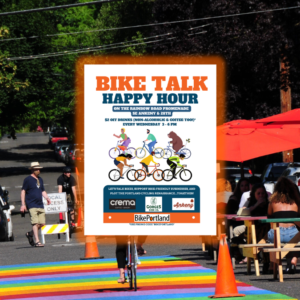
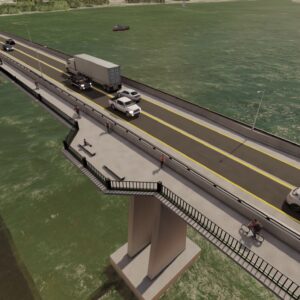

Thanks for reading.
BikePortland has served this community with independent community journalism since 2005. We rely on subscriptions from readers like you to survive. Your financial support is vital in keeping this valuable resource alive and well.
Please subscribe today to strengthen and expand our work.
They should use abandoned trolleys (a la Spaghetti Factory style) or wagons, etc to meet their ‘transportation activity’ requirements.
Hasn’t it always made more sense to put the seating that people are going to spend time in closest to the building (i.e., on the sidewalk) and have the more transitory pedestrian traffic in the reclaimed space in the street, whether from parking or a travel lane? I’m sure the servers would prefer not having to constantly look out for pedestrian cross-traffic and the diners would rather not be as close to the noise and fumes of passing traffic. I’ve never understood why all these plans put the tables in the street. What am I missing?
Nate,
I really like the idea of replacing on-street parking with a pedestrian realm with bollards or planters separating the space from cars and maybe a few benches separating the retail environment on the sidewalk.
Check out how the do it in Florence, Italy (pre-pandemic). There is a gap for walking. People want to be able to walk up to the front door without walking through the seating area. There are other examples if you search around on streetview
So we basically have that, except the seats closest to the street get to sit next to lifted F250 trucks speeding by.
Yeah, but look where the people are actually walking. This approach works great if you’ve got a massive plaza for your eating area and pedestrians can walk wherever they want. Not so well if those pedestrians walking around are getting run over. Not sure the comparison holds up. There are countless examples of restaurants with existing front patio areas that have a wide path between the tables leading from the sidewalk to the front door and they seem to work fine.
Due to the narrow sidewalk width in Hood River (age of the town/buildings) and steep curbs that configuration would be difficult. It completely makes sense when planned. Also the restaurants are peppered between shops where on-street parking (city revenue) is still allowed, so keeping the sidewalk as the main thoroughfare for pedestrians keeps them from having to walk around seating and back again. (There are only a handful of these parklets built overall, and the downtown now competes with the waterfront for business).
“What if they allowed parklets as long as they’re equipped with wheels?”
This, exactly! Park some flatbed trailers, plop some tables and chairs on them. Done.
Oooh, I like this. Looking at the on-street tables, it just seems uncomfortable to be right in line with a high speed multi-thousand pound vehicle drifting out of the lane because it’s operator is staring at a phone, etc. Put the tables up on an elevated trailer bed and I’d feel a lot safer and more comfortable. Tables immediately adjacent to the building wall can be reserved for customers requiring ADA services and other limited mobility issues (strollers etc.).
How about defining these cafe seating areas as “pedestrian refuelling & rest areas”?
“The origin of today’s rest area system was a provision in the Federal-Aid Highway Act of 1938 that stated “the States with the aid of Federal Funds may include . .. such sanitary and other facilities as may be deemed necessary to provide for the suitable accommodation of the public.” The intent of the Act was to increase [transportation facility user] safety and comfort by providing facilities for stopping and resting. Subsequent Federal-Aid Highway Acts, the Highway Trust Fund, and the Highway Beautification Act of 1965 gave authority, funding, and sub- stance to the rest area program.” – M.A. Perfather, Operation and Motorist Usage of Interstate Rest Areas and Welcome Centers in Virginia; TRB 1224
I am surprised at how fast ODoT reacted to this request (probably faster since it was NOT in Portland and in a small rural city) per politics. And also the good news that ODoT is working with the City of Hood River had to request a jurisdictional transfer. 😉
I was going to half-jokingly say the same thing but you did even better by finding a reference and (below) the handbook. I would also propose the parklets could be called “Congestion Relief” for the sidewalk.
Or, as a last resort, since parked vehicles are OK, rent the lowest flatbed truck you can find, park it in front of the business, and construct an ADA-slope-compliant ramp up from the sidewalk to the flatbed. Leave a 1/2″ gap between the landing and the bed, and nobody can claim its a structure in the street. It has the added benefit that diners are up above noisy traffic rather than right next to it.
dock ramps and plates from U-line are about the best $ deal…
Additionally, perhaps Micheal Ronkin has been away from ODoT so long now (12 years?) that ODoT forgot about its Main Street Handbook manual? This Hood River project is a perfect example.
https://nacto.org/wp-content/uploads/2015/04/mainstreethandbook.pdf
I know it is hard to accept, what law says, but as a person involved with this issue, I can offer that there is specific clause in the highway fund that restricts the use of RoW to Transportation use. State routes are built and maintained by highway fund and DoJ has clear guideline that from that fund nothing can be directed to other things. We offered the City that we would accommodate pedestrian use of the road space if they could move the parklets to sidewalk. Problem was that city permitted businesses to install these parklets before they come to ODOT to get permit for use of Right of Way. Then our only option was to let the City take over the road.
Maybe more Oregon towns should borrow a page from Bend…sanction parklets on Main Street ODoT highways and then seek transfer of ownership. (Assuming they have the tax base to maintain the asset.
LOL better check emergency SB1601 the state highway fund has been cracked open for public transport! YOUR WELCOME. And nobody should ever EVER take design ideas from Grants Pass, they can’t keep their libraries open or control their sheriffs. That ODOT inspired visual monstrosity would never pass the visual scenic amenity inspired by the Hood River businesses parklet. Sheesh Rian, haven’t you ever sat through a Gorge Commission meeting? You can’t load the Gorge with orange ugly maintenance crap. It’s not SCENIC, which is the whole point of the National Scenic Area, should be visually appealing from the other side of the river via Key Scenic View points. Did you get the memo? ODOT can’t over ride a national scenic zone.
Nice try, again ODOT doing whatever ODOT wants to do.
put little wheels on the tables. Gotta love bureaucracy.
And pedals…and reflectors too…
With all ODOT has on their plate, I don’t know why they would want to be trying to micromanage every inch of a downtown business district which represents such a tiny fraction of the road miles they need to maintain. Its just so far out of their expertise and interest and seems like would just be a headache for them. These types of historic business districts should have been turned over to the local government a long time ago, so that the character of the district can be controlled by the locals. Just divert the portion of money that ODOT spends on these business districts to a state fund that towns can apply to for matching grants to improve and maintain them.
Am I the only one experiencing cognitive dissonance after reading the previous story (about PBOT’s objections to the Fed’s taking over the city ROW) and then this story (about ODOT’s objections to a city taking over the state ROW)?
Cyclists will fight to defend the ROW when it’s taken away from cyclists, but is that impulse not applicable for other modes? I get that ODOT is inflexible and bureaucratic and hidebound and whatever the opposite of “innovative” is, but consistency is still important.
…especially since ODOT worked with the city for a solution and facilitated the parklets being able to remain. Yes, the business owners had to deal with mixed messaging and frustration during an already-challenging time (I know some of them), but things worked out. The Dalles also has parklets on Highway 30.